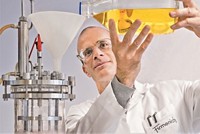Advertisement
Grab your lab coat. Let's get started
Welcome!
Welcome!
Create an account below to get 6 C&EN articles per month, receive newsletters and more - all free.
It seems this is your first time logging in online. Please enter the following information to continue.
As an ACS member you automatically get access to this site. All we need is few more details to create your reading experience.
Not you? Sign in with a different account.
Not you? Sign in with a different account.
ERROR 1
ERROR 1
ERROR 2
ERROR 2
ERROR 2
ERROR 2
ERROR 2
Password and Confirm password must match.
If you have an ACS member number, please enter it here so we can link this account to your membership. (optional)
ERROR 2
ACS values your privacy. By submitting your information, you are gaining access to C&EN and subscribing to our weekly newsletter. We use the information you provide to make your reading experience better, and we will never sell your data to third party members.
Business
A Taste Sensation
Sweet and savory uses for biotechnology inspire flavor start-ups
by Melody Voith
April 7, 2008
| A version of this story appeared in
Volume 86, Issue 14

THE ANCIENT LATIN proverb de gustibus non est disputandum is often translated as "there's no accounting for taste." That was then. Now, researchers can account for taste perception, and their basic studies are starting to influence what people eat.
Foods today often contain more sugar, salt, and protein than a healthy diet needs. Chemists in start-up flavor companies are using the tools of biotechnology to reduce the negative health effects and high costs of ingredients used in food, beverages, and pharmaceuticals. Three companies—Senomyx, Redpoint Bio, and Allylix—have borrowed not only the methods of pharmaceutical research firms but their business models as well.
So far, none of the three has reported a profit. All are in the early stages of product development and depend on partnership arrangements and venture capital to pay expenses. Each hopes that one or more of its products will become the food industry's version of a blockbuster drug.
"We've essentially taken the concept of high-throughput screening as used in biotech and pharmaceuticals and directed it to looking for new flavors," says Gwen Rosenberg, vice president of investor relations at Senomyx.
Before such screening could provide "hits" on taste-reactive molecules, however, researchers had to learn a lot more about how the sense of taste works.
What the brain perceives as flavor is a complex interplay of smell and taste. Bumps on the human tongue called fungiform papillae collectively have around 100,000 taste buds. Each taste bud contains 50–100 specialized receptor cells. The five taste qualities—sweet, sour, salty, bitter, and umami, or savory—each have a specific signaling pathway; they can also work in combination.
Salty and sour sensing receptors have ion channels that admit the tastant (such as sodium ions from table salt) into the cells, triggering a nerve impulse that the brain translates as salty or sour. Sweet, umami, and bitter receptors respond to sugars, amino acids, and plant alkaloids through G-protein-coupled receptors on their surfaces. A G-protein called gustducin initiates a "bucket brigade" of signals to trigger a nerve impulse that is translated into one of the three tastes.
The receptors and their signaling pathways provide tantalizing targets for flavor researchers to create, enhance, or block taste perception. John C. Leffingwell, president of Leffingwell & Associates, a consulting firm serving the flavor and fragrance industry, says it's too soon to predict success for biotech-discovered ingredients, but he is intrigued.
"The idea behind these flavor enhancers is new. Start-up companies are trying to create a niche for themselves in a strange and different way," Leffingwell says. "The potential demand and market is huge. For example, Coca-Cola has contracts with both Senomyx and Redpoint. How much Coke is sold in the world?"
Senomyx was founded in 1998 to capitalize on discoveries made by Charles S. Zuker of the University of California, San Diego, about how taste receptors work in rodents. The research provided a jumping-off point to look for human receptors. The company went public in 2004 and now has about 120 employees, 75% of whom are in discovery and development.
Rosenberg says the difference between flavor research at Senomyx and traditional flavor companies is that the latter look at known flavors. "An example might be chili peppers. They'll reverse engineer it, and ask themselves 'What causes the unique flavor?' But their innovation does not come from using the actual science of taste to find new flavors," she says.

SENOMYX USES human taste receptors as the basis of assays for high-throughput compound screening. Any compound that activates the receptor is put in a water solution for a taste test and compared with a control of the product it is meant to enhance. If it passes that test, researchers try it in a more complex solution, like a beverage. After that point, product development and taste testing is similar to what goes on in a typical food or flavor company.
Senomyx uses libraries of 500,000 natural and synthetic samples and actively looks for new sources. "Our natural libraries usually come as compounds or extracts, meaning we probably have over a million different molecules," Rosenberg says.
In its year-end financial statement, released in February, Senomyx reported the identification of what its scientists believe is the primary receptor responsible for human salt taste perception. The company hopes an assay based on the salt receptor will lead to an ingredient that can enhance the taste of salt in food and beverages.
Senomyx is not a food manufacturer. The company partners with food, beverage, and larger flavor and fragrance companies to commercialize its ingredients. Currently, it has product discovery and development collaborations with Ajinomoto, Cadbury Schweppes, Campbell Soup, Coca-Cola, Firmenich, Nestlé, and Solae. The partnerships brought in revenues of $18.2 million in 2007, although Senomyx reported a net loss of $21 million.

Nestlé has commercialized Senomyx' savory flavor enhancers in six consumer products for sale in four countries in Latin America and the Pacific Rim. The savory taste receptor led researchers to a flavor enhancer that reduces or eliminates the need for monosodium glutamate.
The flavor partnerships mirror those between large drugmakers and nimble biotech start-ups, according to Rosenberg. "We used the concept of how biotech companies will enter into agreements with large pharmaceutical firms with a royalty on sales," she says. Partner companies receive an exclusive right to products from one or two scientific discovery programs, for a particular food product category, and for a particular region of the world.
Redpoint Bio's approach to flavor discovery started with a mouse that didn't care for cheese. Robert F. Margolskee of Mount Sinai School of Medicine bred mice that had taste receptors but did not perceive the glutamic acid flavor of cheese or the sugar in sweetened food. Notably, they would even drink bitter solutions that mice normally avoid.
Margolskee had knocked out the gene sequence for the TRPM5 calcium channel, an important step in the pathway that amplifies the taste signal like a volume control. Knocking out genes, however, is not always practical, so the company's founders began to look for a bitter-blocker to make children's medicine easier to take. "We saw a tremendous opportunity to enable drug delivery through oral mucosa in the mouth" says F. Raymond Salemme, Redpoint's chief executive officer.
ON THE WAY to the formulary, however, Redpoint researchers discovered they could turn the volume control up as well as down. They began the search for a compound that could be used in minute amounts—as low as parts per million—to increase the perception of sugar in a soft drink without it tasting artificial.
Redpoint has 31 employees and has announced partnerships with Coca-Cola and the Swiss flavors and fragrances giant Givaudan. Although none of its products are on the market, research partnerships gave the company revenues of $2.2 million in 2007. Still, the company reported a net loss of $10 million.
Robert G. Eilerman, senior vice president for global science and technology at Givaudan Flavours, emphasizes that his company has a strong in-house molecular biology effort that includes high-throughput screening. The collaboration with Redpoint enhances Givaudan's in-house capabilities and allows it to take advantage of the TRPM5 channel, he says.
Salemme characterizes Redpoint's flavor research as basically indistinguishable from the world of biotechnology until the "hit" reaches the stage of product development. At that point, the food industry's idea of what makes a good candidate diverges from the pharmaceutical model.
A promising ingredient must be generally recognized as safe, have a good shelf life, and not degrade when heated or exposed to light. It also helps if it can be considered natural. "We do a lot of synthetic chemistry to find a compound with an optimal set of properties. We also work with natural products. In the flavors and fragrance industry there is a tremendous interest in natural products for labeling purposes," Salemme says.
SIMILARLY, the popularity of natural ingredients drives Allylix, a maker of natural flavors that uses different biotechnology processes to create its products. The company develops specially engineered enzymes called synthases that produce a variety of plant terpenes by standard fermentation. Scientific founders Joseph Chappell of the University of Kentucky and Joseph P. Noel of the Salk Institute for Biological Studies, in San Diego, developed the molecular engineering techniques in the 1990s.
The first Allylix product is the grapefruit essence, nootkatone, which is commonly extracted from grapefruit peels. The firm claims that the fermentation route produces high-purity products at much lower cost.
"From a commercial perspective, plant terpenes are very interesting. Many of them have antibiotic, flavor, and fragrance properties," says CEO Carolyn Fritz, who joined the company from Dow Chemical in 2005.
In November 2007, Allylix received $3.35 million in venture capital financing to launch its first three products. Fritz says nootkatone will be available in fall 2008. The pipeline also contains fragrance and insect-repellent products based on sesquiterpenes.
In the global flavor and fragrance market—worth an estimated $22 billion a year—biotech start-up companies aren't even on the radar yet. But they do have advantages over larger players, according to Leffingwell. "Historically, companies would say, 'I'm going to synthesize 500 compounds each year and then do taste tests.' You don't know if you'll find anything." Small companies are combining the new understanding of taste perception with high-tech screening and biochemical engineering to discover new compounds and produce them faster.
But small companies also face challenges. Start-up costs for sophisticated technologies are high, and it can take years to get new products to market. Partnerships with larger companies are a necessity.
"I'd be surprised if one if them isn't acquired," Leffingwell says. "Some flavor companies spend over a $100 million per year on R&D. This is an area that requires a different type of expertise than they historically have. To add that to their bailiwick would be a coup."






Join the conversation
Contact the reporter
Submit a Letter to the Editor for publication
Engage with us on Twitter